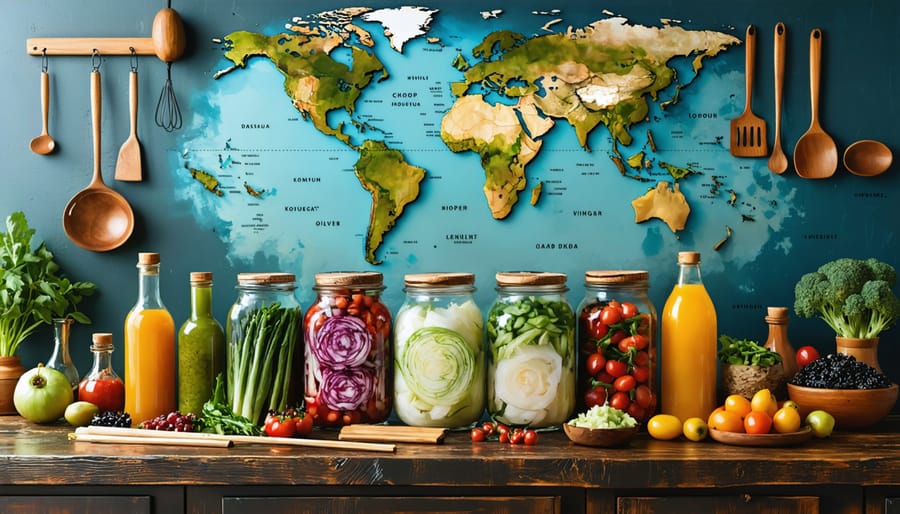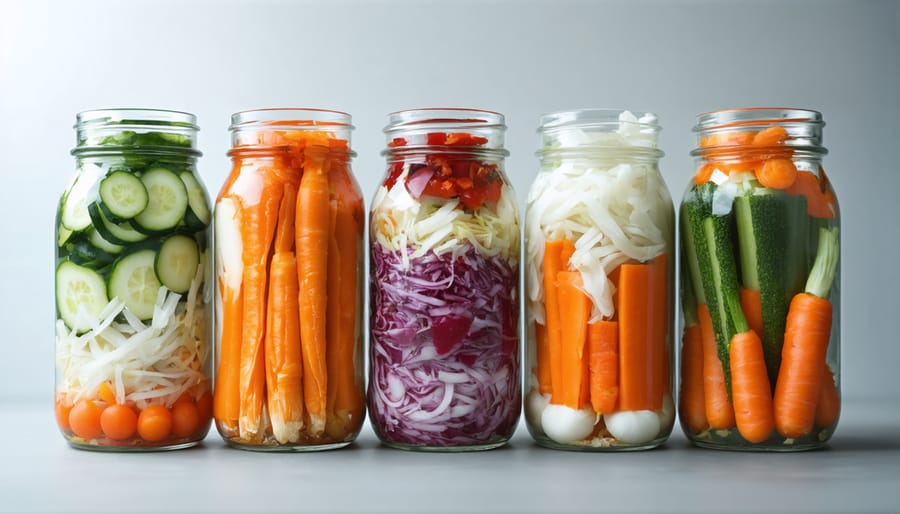
Transform your kitchen into a living laboratory of flavors and discover a healthier relationship with food through the ancient art of fermentation. This time-honored practice isn’t just about preservation—it’s a gateway to enhanced nutrition, complex flavors, and a deeper connection to traditional food preparation methods that span cultures worldwide.
From the tangy kick of sauerkraut to the effervescent fizz of kombucha, fermentation has been quietly revolutionizing our pantries for thousands of years. Whether you’re a curious home cook or a wellness enthusiast, understanding the three primary types of fermentation—lactic acid, alcohol, and acetic acid—opens up a world of culinary possibilities and health benefits right in your own kitchen.
Today, we’ll explore these fundamental fermentation processes, demystifying the science while keeping things practical and approachable. Get ready to harness the power of beneficial bacteria and yeasts to create everything from probiotic-rich vegetables to bubbly beverages that will transform your everyday meals into something extraordinary.
Lactic Acid Fermentation: The Art of Vegetable Preservation

From Korean Kimchi to German Sauerkraut
I first discovered the magic of vegetable fermentation during a cooking class in Seoul, where our instructor showed us how to make traditional kimchi. The way she massaged salt into crisp napa cabbage leaves and mixed in the vibrant red pepper paste reminded me that this ancient practice connects cultures worldwide.
From the tangy crunch of Korean kimchi to the mellow bite of German sauerkraut, fermented vegetables are a testament to human ingenuity in food preservation. The basic process is wonderfully simple: vegetables are submerged in a salt brine, creating an environment where beneficial bacteria can thrive while harmful ones can’t survive.
What I love most about vegetable fermentation is how each culture adds its unique twist. Japanese tsukemono might include rice bran for fermentation, while Indian achaar incorporates aromatic spices like fenugreek and mustard seeds. In my own kitchen, I’ve found that starting with simple sauerkraut – just cabbage and salt – is the perfect introduction to this fascinating world.
The best part? You don’t need any special equipment to get started. A clean jar, fresh vegetables, and good quality salt are all it takes. Whether you’re drawn to the probiotic benefits or the complex flavors, vegetable fermentation offers an accessible way to connect with food traditions from around the globe while creating something deliciously unique in your own home.
Getting Started with Veggie Ferments at Home
Starting your fermentation journey at home can feel like a delightful mix of science and kitchen magic. As someone who was once intimidated by the process, I can assure you that vegetable fermentation is one of the most forgiving ways to begin. Just like developing mindful kitchen practices, fermentation teaches us patience and observation.
Begin with simple vegetables like cabbage, carrots, or radishes. You’ll need a clean glass jar, sea salt, filtered water, and your chosen vegetables. Wash your vegetables thoroughly and chop them into uniform pieces. For cabbage, massage it with salt until it releases its natural juices. For other vegetables, create a basic brine using 2 tablespoons of salt per quart of water.
Pack your vegetables tightly in the jar, ensuring they’re completely submerged in their liquid. A fermentation weight or even a cabbage leaf can help keep everything below the surface. Cover with a loose lid or fermentation cap to allow gases to escape.
Store your jar at room temperature (65-75°F) for 3-7 days, checking daily. You’ll notice bubbles forming and a slightly tangy aroma developing – these are good signs! Once you’re happy with the flavor, transfer to the refrigerator to slow the fermentation process.
Remember, every batch is unique, and that’s part of the joy. Trust your senses and don’t be afraid to experiment with different vegetables and spice combinations.
Alcoholic Fermentation: Beyond Wine and Beer
Traditional Beverages Around the Globe
Fermented beverages have been part of human culture for thousands of years, each telling a unique story of tradition and craftsmanship. While some might already be familiar with essential home beverages, there’s a whole world of fascinating fermented drinks to explore.
Take kombucha, for instance – this fizzy, tangy tea has become a modern wellness sensation, but it’s actually been around for over 2,000 years! Originally from Northeast China, it’s made by fermenting sweetened tea with a SCOBY (Symbiotic Culture of Bacteria and Yeast). The result? A refreshing drink packed with potential probiotics.
In Japan, sake holds a special place in cultural ceremonies and celebrations. This rice wine undergoes multiple fermentation stages, transforming humble grains into an elegant beverage that can be served either warm or chilled. I’ll never forget my first sake tasting experience – it opened my eyes to how complex and varied fermented drinks can be.
Mead, often called honey wine, might be the oldest fermented beverage in history. Made simply from honey, water, and yeast, it was once known as the “drink of the gods” in many ancient cultures. Today, craft meaderies are bringing this historic drink back into the spotlight, often infusing it with fruits and spices for modern palates.

The Science Behind the Bubbles
Have you ever wondered what makes your kombucha fizzy or your sourdough rise? Let me share the fascinating world of fermentation bubbles with you! As someone who was initially mystified by this process, I’ve come to appreciate the beautiful simplicity behind it.
At its heart, fermentation is like hosting a microscopic dinner party where tiny organisms (usually yeast or bacteria) feast on sugars and carbohydrates. As these helpful microbes enjoy their meal, they produce two main byproducts: carbon dioxide (those delightful bubbles!) and either alcohol or acid, depending on the type of fermentation.
For this bubbly magic to happen, we need three key conditions: the right temperature (usually room temperature works perfectly), an oxygen-free environment, and some form of sugar for our microscopic friends to eat. Think of it as creating the perfect spa day for your beneficial bacteria!
The bubbles themselves are actually trapped carbon dioxide gas, which builds up during the fermentation process. In beverages like kombucha or kefir, these bubbles create that satisfying fizz we love. In bread making, they’re responsible for those beautiful air pockets that make your loaf light and fluffy.
Remember, patience is key – good fermentation can’t be rushed. The bubbles will appear when your tiny helpers are happy and well-fed, usually within a few days to a week, depending on what you’re making.
Acetic Acid Fermentation: The Magic of Vinegar Making
From Apple Cider to Rice Vinegar
I remember the first time I discovered the tangy world of vinegars during a cooking class in San Francisco. Like many of you, I’d only known the basic white vinegar sitting in my pantry, but there’s so much more to these fermented flavors!
From the sweet-tart notes of apple cider vinegar, beloved in American folk medicine and cooking, to the delicate complexity of Japanese rice vinegar, each variety tells a story of cultural heritage and culinary innovation. In Mediterranean kitchens, you’ll find red and white wine vinegars adding depth to salad dressings and marinades, while Chinese black vinegar brings its distinctive umami punch to dumplings and stir-fries.
What fascinates me most is how different cultures have developed their signature vinegars through fermentation. For instance, balsamic vinegar from Modena, Italy, starts as grape must and transforms over years (sometimes decades!) into liquid gold. In Korea, persimmon vinegar isn’t just a condiment – it’s considered a health tonic.
The beauty of vinegar fermentation lies in its simplicity: all you need is a source of alcohol, beneficial bacteria, and time. Whether you’re drizzling rice vinegar over sushi or adding a splash of apple cider vinegar to your morning routine, you’re participating in a tradition that spans continents and generations. Each bottle in your kitchen is a testament to the incredible relationship between humans and beneficial bacteria.

Creating Your Own Vinegar Garden
Creating your own vinegar garden at home is easier than you might think, and it’s such a rewarding process! I started my vinegar-making journey last year, and I’m excited to share these simple steps with you.
First, choose your base ingredient. Fresh fruits like apples, grapes, or pears work beautifully, but you can also use wine or beer. I personally love using excess wine from gatherings – it’s a wonderful way to prevent waste while creating something new!
Start by cleaning a wide-mouth glass jar thoroughly. The container should be large enough to allow good air circulation. Add your chosen fruit or alcohol base, leaving enough space at the top. For fruit-based vinegar, you’ll want to add a sugar solution (1 part sugar to 2 parts water) to help the fermentation process along.
The magic ingredient is what we call “mother of vinegar” – those helpful bacteria that transform your base into vinegar. You can either purchase this or borrow some from existing unpasteurized vinegar. Cover the jar with a clean cloth or coffee filter secured with a rubber band – this keeps out unwanted visitors while letting your vinegar breathe.
Store your jar in a dark, room-temperature spot (around 70-80°F is perfect), and be patient! The process typically takes 3-4 weeks, though some vinegars might need longer. You’ll know it’s ready when you notice that distinctive tangy aroma and taste.
As we’ve explored together, fermentation isn’t just a fascinating scientific process – it’s a magical transformation that connects us to centuries of culinary tradition across the globe. From the tangy kimchi of Korea to the crusty sourdough breads of Europe, fermented foods have shaped our cultural identities and continue to nourish us in delicious ways.
I encourage you to start your own fermentation journey at home. Begin with something simple like kombucha or sauerkraut, and let your confidence grow with each successful batch. Remember, our ancestors perfected these techniques without modern equipment or precise measurements – you can too!
Whether you’re drawn to the health benefits, the unique flavors, or the satisfaction of creating something with your own hands, fermentation offers a wonderful way to connect with food on a deeper level. So grab those mason jars, embrace the bubbling magic of beneficial bacteria, and join the growing community of home fermenters. Your taste buds – and your gut – will thank you!



